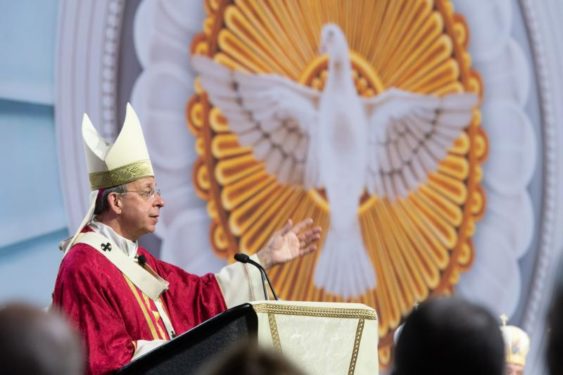
By Christopher White and Ines San Martin
FORT WORTH, Texas (Crux) – Earlier this year Archbishop William Lori penned a pastoral letter calling for the Catholic Church to overcome division by using principles outlined by the late Rev. Dr. Martin Luther King Jr.
As the leader of Baltimore’s Catholics, Archbishop Lori knows firsthand the way in which the issue of race has divided Catholics in his diocese. At this week’s V Encuentro – the culmination of a four-year discernment process in parishes, dioceses and episcopal regions in the United States on the future of the Hispanic Church in this country – Archbishop Lori spoke about how the legacy of MLK can help overcome segregation in the U.S. Church, as well as how Our Lady of Guadalupe is a miracle of evangelization that can be shared by Hispanic and non-Hispanic Catholics alike.
Crux: You’ve recently written a pastoral letter focusing on Dr. Martin Luther King, Jr. and overcoming racism. Oftentimes in this country, Hispanic Catholics are discriminated against and viewed as a segregated part of the U.S. Church. What insights do you think MLK can offer us here at the Encuentro?
Archbishop William Lori: My pastoral letter focused on the life and legacy of Dr. Martin Luther King Jr. and his principles of non-violence. As you study him and read him, you see how he sought to build bridges, how he sought to lessen misunderstanding without sacrificing honesty, and how he sought really to change people’s minds and hearts. He was a great civil rights leader, but he was also a great spiritual leader.
I think the same thing applies with the Hispanic community, because often it’s regarded as a specialty ministry that is done off on the side. Sometimes it’s regarded as an intrusion on an otherwise happy and self-satisfied Anglo parish, when in reality, it’s becoming our mainstream.
It seems to me that building those bridges are important.
I’ve heard a lot of that here at the Encuentro, how to do that and good practices for it. It’s not simply saying, ‘We have Mass in Spanish, but those folks come at 2 p.m. on Sunday afternoon and we come at 10 a.m..’ Isn’t there a way that things can be done together? Aren’t there devotions in common? Shouldn’t our pastoral councils reflect the realities of the whole parish? Shouldn’t the diocesan offices also reflect that reality?
I would be the first to say I have a long way to go in my shop, but I think that would be how I would see the relationship between what I wrote about Dr. King and what we’re talking about these days.
This morning we heard Supreme Knight Carl Anderson of the Knights of Columbus say that he’d like the U.S. Bishops to name Our Lady of Guadalupe as patroness of the United States. As a U.S. bishop and as the chaplain of the Knights, are you going to help make this happen?
When you study Our Lady of Guadalupe, she is really a summation of Mariology. If you look deeply at the symbolism and her vestry, for example, the Immaculate Conception is surely there. I don’t know what the immediate future of that proposal is. I do know though, that Our Lady of Guadalupe and devotion to her is one of the things that ought to bring us together. We all ought to be her children.
We also heard Carl Anderson say that today the Church in the United States lives a miracle because of Our Lady of Guadalupe, which of course means the Hispanic presence in the U.S. Do you think the Hispanic Community can be a miracle in a country that is very much in need of that?
I do. She was a miracle of evangelization that went from failing evangelization efforts to an evangelizing boom after Tepeyac.
In our United States, we find that many of our parishes are aging. We find that we are losing our young people. We find that we are ridden by scandal, and we find that while we work hard at evangelization – and there are successes, and they should be celebrated, and there are truly vibrant parishes and ministries – really, the door that is being opened to the Church in the United States is the Hispanic reality, and that’s the miracle that I think our Supreme Knight Carl Anderson is pointing out to us.
You’ve spoken of a Church ridden by scandal. Has the scandal of clerical sex abuse overshadowed what’s happening here at the Encuentro?
What I’m finding is that it’s acknowledged in all of its dimensions, but what I’m seeing here is a beautiful love for the Catholic faith. What I’m seeing here is a vitality and an attention to overcoming the person of Christ in whom we can overcome all things. That’s what I’m seeing here.
This is for me, like an antidote. It’s not an escape, it’s different things. It’s helping us to figure out where we go from here. We have to acknowledge all of this, and there will be many difficult consequences, but we are also talking about rebuilding. Here we are and this is where we rebuild.
